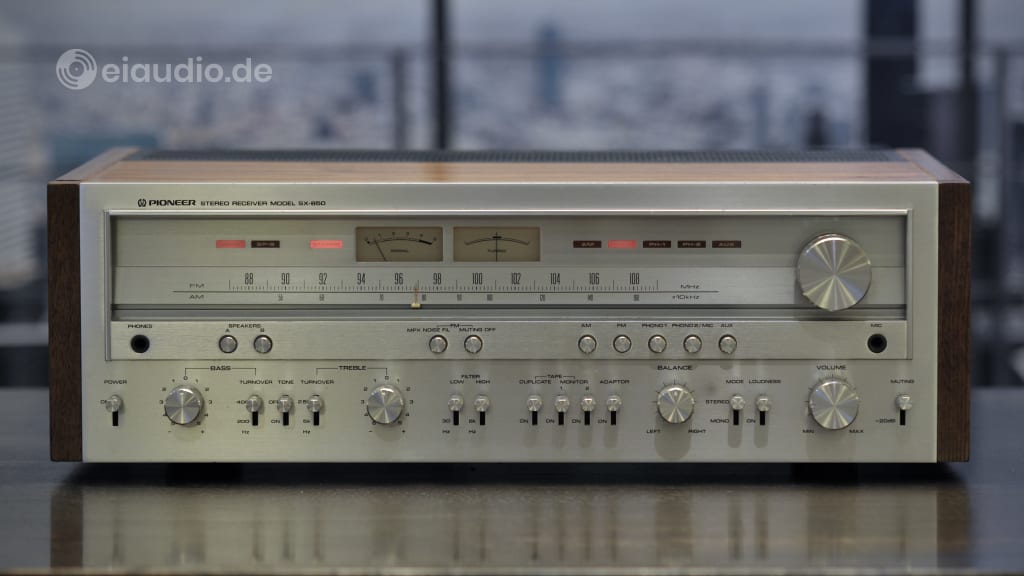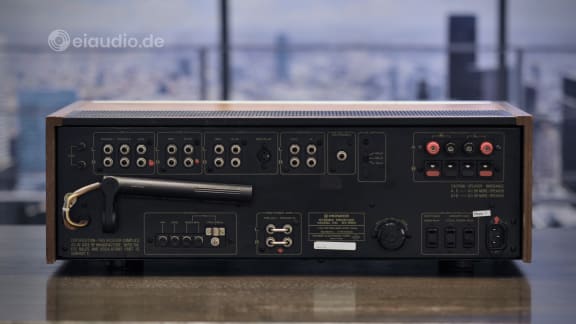Pioneer SX 850
Published: 26/04/2022
Manufacturing date: 1976
Author: Karsten Hein
Category: Gear & Review
Tag(s): Receivers
Paionia Kabushiki-gaisha, a Japanese company henceforth referred to as Pioneer, has evolved to be the heir of a long legacy of outstanding professional and domestic electronics. And although receivers made up only a small fraction of the company’s success story, they did serve to promote the Pioneer brand in Europe and the USA. Pioneer is sometimes said to have spawned the infamous ‘Receiver Wars’ during the Golden Age of audio in the decade spanning from 1971 to 1981.
The ‘Golden Age’ of audio is sometimes referred to as such, because consumers in this era were willing to spend a considerable portion of their income on advances in Hi-Fi, thereby giving manufacturers the financial resources to incorporate long-lasting quality components, and the freedom to conduct intensive research in order to build the best devices they possibly could. In those days, the market was still dominated by privately owned and research-driven companies that were fighting for pole position in the newly emerging Hi-Fi magazines.
Pioneer was a case in point. Owned and operated by the Matsumoto family, the company already had a thirty-year history in manufacturing audio electronics by they launched the SX 850. The concept of an all-in-one control unit that included tuner, preamp, and power amplifier had originally been invented by the American Harman Kardon corporation during the 50s. However, Japanese manufacturers, such as Marantz, Sansui, and Pioneer, followed suit and soon rivalled Harman Kardon in terms of quality, performance, and especially cost.
Advert eiaudio/shop:
Despite having established a strong manufacturing base in Japan, Hi-Fi receivers continued to be mostly manufactured for and sold in the United States and Europe, as Japanese audio enthusiasts preferred the sound and versatility of separate units over the combined package. Customers in western countries, on the other hand, enjoyed the fact that they could get very close to the performance of separate units while having to put up with less than half the fuss. It may have also helped sales that most receivers featured large illuminated scales and fancy looking front-panel designs that increased the wife-acceptance-factor.
On the downside, receivers usually offered less power than separate amplifiers. Or at least this was the case before Pioneer, staying true to their name, released the world’s first genuine 100 watts per channel receiver. This was even certified by the United States Federal Trade Commission (FTC) that had started to regulate the audio market, due to an increase in false promises on the side of manufacturers. Released in 1974, the SX-1010 was Pioneer’s (then) flagship receiver and out-performed the competition by almost 40 watts per channel. Unfortunately, the glory turned out to be short-lived. In August of that same year, the Japanese Marantz corporation followed suit with their legendary 2325 model that boasted 125 watts per channel. The receiver wars had officially begun, with each manufacturer aiming to out-perform the competition in terms of sound quality and power output.
Although the SX 850 fell into this time period, its moderate 65 WPC into 8 Ohms indicated that it was not a contender in the on-going war effort. This, however, could just as well be seen as a plus, because not all monster receivers turned out to be well-equipped for audiophile usage or were in it for the long-haul. In a real-world scenario, 65 honest watts into eight Ohms (and 85 watts into four Ohms) were perfectly capable of driving most conventional 2-way or 3-way speakers on the market. And, while the Receiver Wars did go on to produce true monsters capable of powering even electrostatic speakers and other unruly designs, the SX 850 was most fitting for dynamic speakers of medium to high sensitivity from 4-8 Ohms.
The specimen shown here had been restored to its original splendour in the weeks prior to our listening tests. Its switches had been cleaned in an ultrasound bath, the capacitors had been checked and replaced where necessary. The relays had been cleaned, and the offset calibrated according to factory standard. The original lamps (that were prone to failing) had been replaced with longer lasting LED lights. The real-wood case had been freed from scratches and re-polished to its original shine. To improve connectivity, an IEC socket had been installed that replaced the original US cord, and four banana/spade terminals had been added in position of speaker output “A”. The SX 850 had been restored to better than NOS condition. Its look and feel made it seem as if no time had passed since 1976.
The SX 850’s impressive width and weight would have served to give it a noticeably prominent position on any Hi-Fi rack or piece of furniture. And working on the buttons and switches felt more like operating the control panel of a submarine than those of a common household radio. In fact, I was so surprised by the Pioneer’s weight and haptics that I felt compelled to open the unit in order to see where this impression originated from. However, in my explorations I could neither confirm the large transformer nor the wooden casing or chassis to be the sole cause of its weight and solid feel. It was rather the sum of all quality choices that in the end led to this unit’s close to 20 kilograms of weight and its superb rigidity. The 850 was seven impressive kilos heavier than even the twin-powered Harman Kardon 730.
Recently refurbished units often had a tendency of sounding a bit stale until the new components had been sufficiently run-in to become part of the greater scheme. And it was difficult for me to say in which phase of the running-in process our specimen really was and how much of my sonic impression was affected by this condition. However, having been present during the break-in of many devices, I felt sufficiently knowledgeable to identify areas of potential. If some units will feel a bit light-footed and short-winded during the first couple of weeks, this particular receiver greeted me with a huge sound stage spanning from far left to far right, a solid and dependable center image, and a thick and musky sound. It was as if it was painting with a broad brush.
Even coming from our Restek V1 and Becker ST-200 separates, I could not help but be drawn in by the SX 850’s colourful and engaging sound. Similar to the Becker, the Pioneer was more about the sensation of listening to musicians playing their instruments live than it was about being present in the highly accurate mastering room of a recording studio, especially during passages of instrumental Jazz. Brushes sounded convincingly metallic and still had a pleasant softness about them. I enjoyed this quality a lot on Tony Bennett & Diana Krall’s album “Love is here to stay”. Similarly, both nylon and steel guitars had a natural timbre with a pleasantly soft top-end, as I experienced listening to José González album “Local Valley”.
The SX 850 certainly understood about music and, in connection with our silver solid core interconnects and Belden speaker wires, offered the stomping and airy bass presence of a live venue. While bass was perhaps not nuanced, multi-layered, or controlled, I personally preferred this type of 'musical' bass to the sterile impression left by some more recent amp designs with damping factors well above 200. In its current state, the Pioneer was perfectly suitable for extended listening sessions, even for listeners who have high expectations regarding their choice of audio entertainment.
Both male and female vocals sounded lush and full-bodied with an aura of slight restraint. There was just not as much air and space around the singers as I was used to from our Restek & Becker combination. When it came to vocals, I could not shake the feeling that I was sitting in a recording studio. This is not to say that there was anything unpleasant in the way vocals were depicted, they simply sounded less live and had less of a physical aura than (strangely enough) the instruments did. It seems that the mid-band was not able to breathe as freely (yet) as some of the higher and lower spectrum. This may have been a result of the still ongoing running-in phase, but it could also have been caused by the unit's design. In the end it does not matter too much, because, if we consider that my benchmark was my favoured combination of separate audiophile units, the SX 850 already put up a formidable performance.
For audiophiles in search of a classic solution for their second or third system who do not shy away from the cost of a (by now necessary) refurbishment, Pioneer sure has some worthwhile receivers from the Golden Age to consider. And the SX 850 was certainly a specimen that I could personally grow attached to. Its colourful and engaging sound, its superb musicality and impressive stage width made it an endearing companion for long and joyful audio sessions any day. Equipped with two MM phono inputs with excellent RIAA correction, two tape monitors, a microphone input and headphone output jack, it is well suitable for most applications. It even features a very convenient -20dB muting switch by which the volume dial can be adjusted to accomodate high input devices, high sensitivity speakers, or both.
Pioneer Company History
The world famous electronics company was founded by the Japanese inventor and entrepreneur Nozomu Matsumoto. Born in 1905, the son of a Kobe missionary family showed an early interest in electronics and was among the first to recognise the potential of recorded music in the context of addressing people’s emotions and felt that this could aid the promotion of the Christian faith.
Therefore, in 1936, he started what was to be the precursor to Pioneer, the “Fukui Denki Shokai Seisakusho”, which translates into the “Gospel Electric Works” in English. His small company took up operations in his hometown Osaka and specialised in the research and development of dynamic loudspeakers.
Matsumoto’s inspiration had come from western companies that still held the lead in entertainment electronics and shipped them over to Japan. However, Matsumoto had a vision of making this a Japanese technology and, in 1937, his early experiments came to fruition with the introduction of the A-8. It was the company’s first large series speaker driver and Matsumoto referred to it as the “Pioneer”. This speaker was the first to feature the ‘omega sign and tuning fork’ that were later to become the company’s trademark.
In 1938, Fukui Denki Shokai Seisakusho moved its operations from Osaka to Tokyo where the growing family business specialised in the construction and repair of loudspeakers. Nozomu Matsumoto made sure to involve his family in the operations and was fully supported in this by his wife Chiyo and his two sons Seiya and Kanya. Following his university studies, Seiya took over Marketing and Sales and went on to become the president of Pioneer in 1982.
The company with the long and difficult Japanese name changed its brand to “Pioneer” in 1962 in an effort to create stronger international brand awareness and went on to become one of the world’s leading developers of first audio and later also video equipment. Pioneer made major contributions in the research and development of loudspeakers, was the driving force behind the development of the laser disk, and next to Sony and Marantz, was one of the first companies to manufacture CD players.
Pioneer stayed true to Matsumoto’s initial mission statement which had been to develop and manufacture audio products that would speak to and captivate people’s emotions. Perhaps it was this deep focus on the true essence of listening that has earned the company a loyal base of followers until this day.
Specifications
- Type: Post WWII AM/FM receiver
- Tuning range: FM, MW, AM
- Power output into 8 Ohms: 65 WPC
- Power output into 4 Ohms: 85 WPC
- Frequency response: 10 Hz to 50.000 Hz (+0 dB, -1 dB)
- Total harmonic distortion: 0.1% @ 8 Ohms
- Damping factor: 25
- 2 Phono inputs: 2.5 mV, 50 kOhms (MM)
- Input sensitivity: 150mV, 100 kOhms (line)
- Microphone sensitivity: 6.5mV
- Signal to noise ratio: 70dB (MM), 90dB (line)
- Signal output: 150mV (line), 30mV (DIN), 1V (Pre out)
- Bass control (100 Hz): ±10 dB
- Treble control (10 kHz): ±10 dB
- Speaker load impedance: 4 Ohms (minimum)
- Semiconductors: 3 x FET, 3 x IC, 56 x transistors, 36 x diodes
- Dimensions: (W) 52.7 cm x (H) 17.3 cm x (D) 41.15 cm
- Weight: 19.1 kg
- Accessories: FM T-type antenna
- Country of manufacture: Japan
- Year(s): 1976






